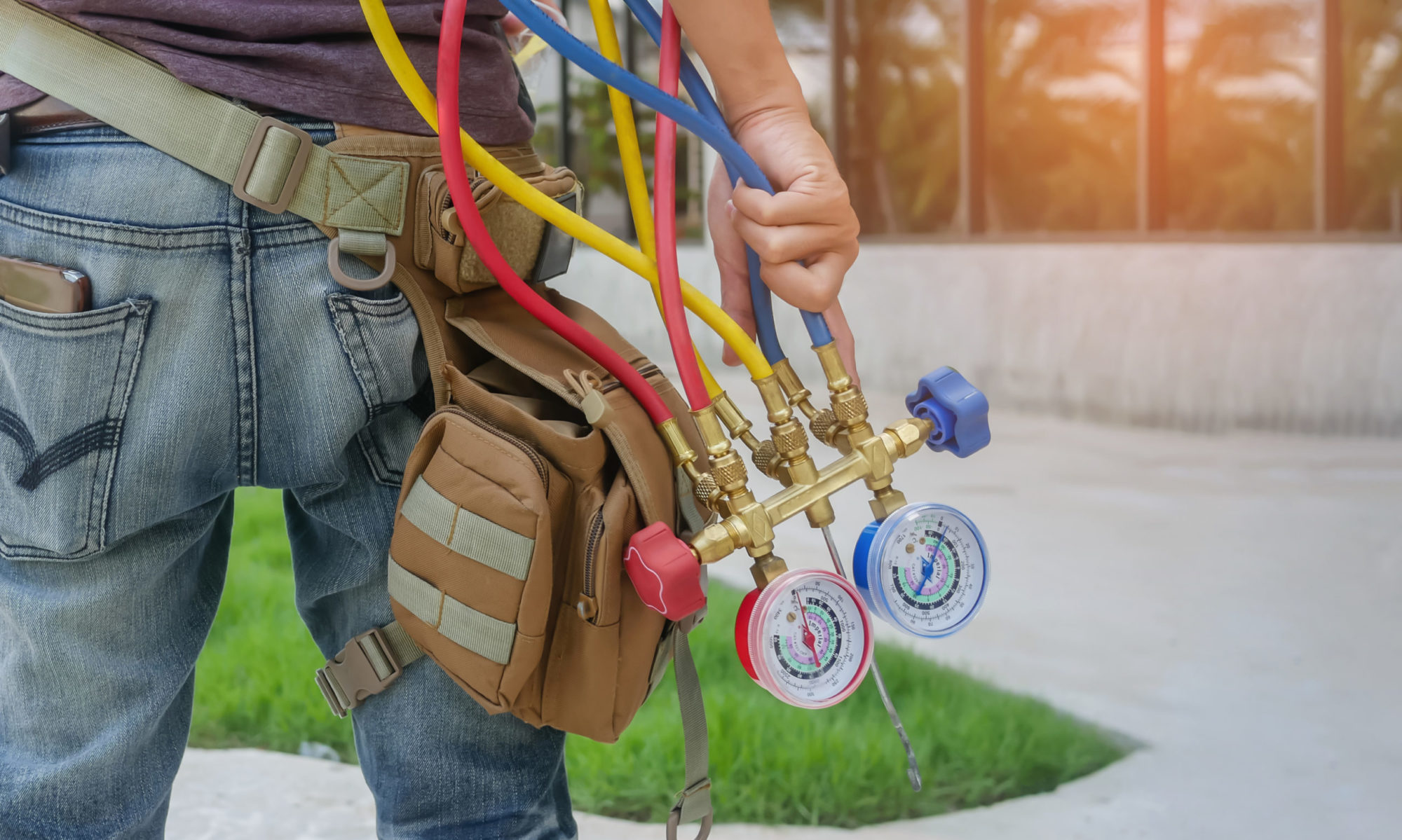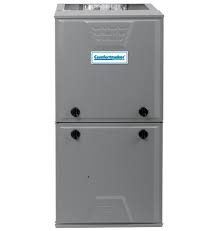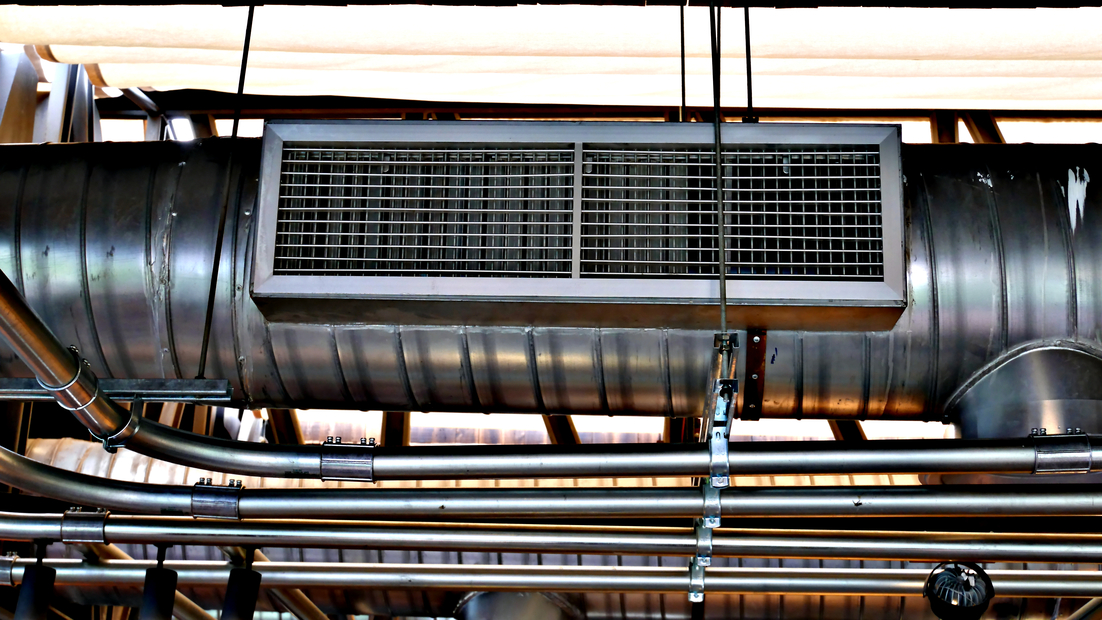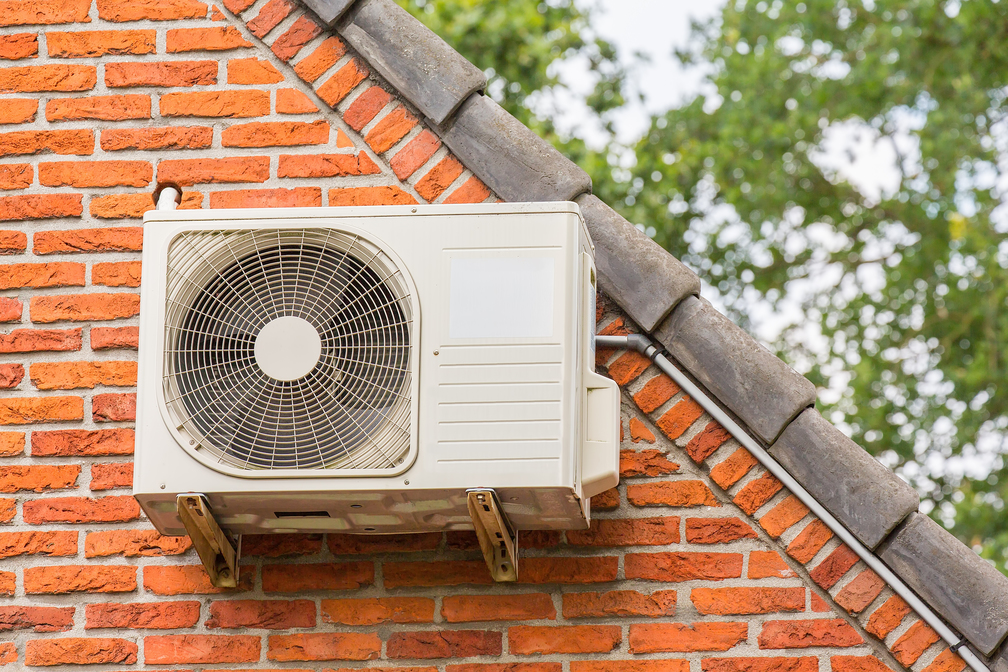For a long time, I refused to even consider the possibility of centralized air conditioning. The summer seasons in my local area are normally brief and often chilly, gray and wet. During the years when we experience high heat and humidity, I never minded opening the windows and running box fans. I had no problem with using window air conditioners in the bedrooms. After the especially long winters and running the heating system at maximum capacity, it was a relief to bring in some fresh air. All of that changed when my youngest daughter was diagnosed with severe allergies. Having the windows open in the spring, summer and early fall became a problem. The influx of bugs, dust, pollen, exhaust fumes and other contaminants worsened her symptoms. I did some research and realized we needed to tighten up the house and filter the air. I contacted a local HVAC company and asked for some recommendations. We started with having the furnace and ductwork thoroughly cleaned and serviced. Duct sealing helped to prevent outside pollutants from entering the system and getting spread throughout the home. The contractor recommended being vigilant about replacing air filters. He also suggested that we install central air conditioning and an air purifier. This combination has made a huge improvement in indoor air quality. The house stays cleaner, smells fresher and feels more comfortable. The air purifier runs 24/7 all year round, requires very little maintenance and combats airborne germs, particles, odors and VOCs. We not only operate the air conditioner during the height of the summer but utilize the fan even during milder weather.
Why you should never install your own air conditioner
Installing your own cooling system can seem like a good idea. Think of the money you can save! You don’t have to pay for the expensive labor and navigate around someone elses time clock. You don’t need to worry about the technician tracking mud, dirt and debris in the house. There is no person leaving materials behind in the home or potentially damaging it in the installation process. Also, imagine how much you learn installing your own cooling system!
Even with those pros, I say don’t do it. If you read my previous blogs, The aftermath of DIY AC installation and Admitting defeat on my DIY AC installation, it is clear that DIY AC installation went terribly bad for me. If you are even thinking of trying this complicated procedure on your own, consider the following cons.
First, did you know that there is a lot of paperwork involved in the process? You also have to wait for the paperwork to go through. If you are adding or even removing an existing air conditioner device, you have to navigate the permit system. The permit system requires talking to county or city officials. You need to pay for the permit and factor in the requirements on each permit.
Second, did you consider how long it is going to take you? Installing your own cooling system will take significant amounts of time. Some HVAC companies send in a team of guys to handle the job quickly. Other times it is one technician, but he is fully certified and can install a cooling system quickly. You are not making a wage when setting up a cooling system. This means your “savings” on not hiring out might actually be costing you money.
Third, there are certification requirements when installing AC. If the unit has refrigerant in it that you are adding or removing, you need to be certified in order to handle it. You can earn an EPA certification, but this costs money and requires an exam being taken! You also have to keep that certification handy anytime you want to get a new refrigerant for the system.
Finally, most people end up messing up their AC installation. Are you really confident in your skills? Are you willing to risk damaging that expensive investment to save a few bucks?
A duct cleaning can pay for itself!
In the majority of homes, the ductwork is largely concealed inside walls, ceilings, attics and crawl spaces. This network of pipes connects the furnace and air conditioner to the various rooms of the house. The duct system is responsible for delivering heated and cooled air while also pulling the stale air out of the rooms. The integrity of the pipes directly affects the efficiency, capacity and reliability of the furnace and air conditioner. The average home collects approximately forty pounds of dust every year. Living in dust are microscopic bugs, such as dust mites, that multiply rapidly and can become a health issue. While continual dusting and vacuuming helps to rid the living environment of pollutants, the dust work is often neglected. Debris gradually builds up within the pipes. This accumulation blocks airflow.
When the maximum amount of conditioned air is restricted from reaching the intended destination, the furnace or air conditioner is required to run more often and use more energy to reach thermostat settings. Along with higher running costs, the added wear and tear increases the risk of malfunction and shortens service life. In addition to dust, the ductwork commonly conceals mold growth, mildew, pollen, lint, pet dander, bugs, webs, decomposing rodents and construction debris.
Heated and cooled air passes through the duct system multiple times. These harmful toxins can easily become airborne and spread into every room of the house. When occupants breathe the contaminants into their lungs, they are at risk of respiratory infections and everything from headaches to asthma attacks. It’s a good idea to have the ductwork professionally inspected and tested every couple of years. Ductwork cleaning is a non-invasive procedure that optimizes the airflow and efficiency of the system. It can help to reduce the workload on the furnace and air conditioner and save a great deal of money on utility bills and repairs.
Reasons why air conditioner maintenance is essential
A modern central air conditioner provides significant benefits, including elevating whole-home comfort and air quality. Today’s cooling systems are typically quite reliable, quiet and energy efficient. While every unit is different, a good quality air conditioner should last between fifteen and twenty years. To get the most value and service life out of the equipment, proper maintenance is necessary. All makes, models, styles and ages of cooling systems require yearly tune-ups to provide reliable longevity. The cooling system is made up of a complexity of components all working together to provide the maximum amount of cool air. Any compromise in integrity of any of the separate parts diminishes capacity and efficiency. Mold, mildew and bacteria thrive in the hot, moist environment inside the air conditioner. These contaminants not only hinder performance but can become airborne and pollute indoor air quality. A dirty air conditioner contributes to a long list of serious health problems. Musty smells from the vents are an indication of microbial growth within the system.
There is also the potential of algae growing in the condensate drain, restricting drainage and leading to water damage. Dust is another problem. Whether the air conditioner is running or sitting idle, dust can work its way into the interior of the system and settle on the various components. Dust impedes the operation of the motor and can result in overheating and failure. Any issues that diminishes airflow is a concern. The air conditioner is then forced to operate more frequently, using more energy and experiencing greater wear and tear. The probability of malfunction and failure increases. The comfort and health of the home suffers. The air conditioner will make more noise, pollute the indoor air and provide inconsistent temperature from one room to another. A yearly tune-up solves these problems. Proactive measures, including cleaning, troubleshooting, testing, tightening and lubricating moving parts works to keep the system operating at its best. Not only will the system cost less to operate, but the professional service fulfills the manufacturer’s warranty requirements.
Why a dehumidifier is a good idea
In the southern area of the country, with especially hot and muggy weather, the air conditioner is essential to comfort. The cooling system often operates for more than half the year, combats temperatures in the triple digits and adds up to a significant electric bill. High humidity is typically a problem. While modern air conditioners are helpful in reducing humidity, they aren’t designed to handle excessive moisture levels. Air conditioners work by pulling heat out of the air and transferring it outdoors by way of refrigerant. Because overly damp air feels warmer than dry air, it can be tempting to lower the thermostat setting. The air conditioner then starts up more often and works for longer cycles. It uses more energy and leads to higher energy costs without solving the problem.
Lower temperature settings can lead to over-cooling the air yet the humidity remains. Along with causing discomfort, high humidity levels can result in damage. Hardwood floors, antiques, wood furnishings, modlings, doors and musical instruments can warp and split. There’s a greater risk of mold and mildew growth and dust mites thrive in moist environments. The degraded air quality is often responsible for health issues such as headaches, difficulty sleeping, coughing and sneezing. High humidity aggravates symptoms of allergies, asthma and respiratory infection. A whole-home dehumidifier provides a significant improvement.
While portable dehumidifiers affect only a single room and require continual upkeep, whole-home dehumidifiers are installed right into the air conditioning system. The device draws moisture out of the air as it passes through the ductwork. The higher end models can be adjusted to preference for humidity levels. The operation is unobtrusive and the accessory only requires annual maintenance. Because of running the dehumidifier, homeowners can raise the temperature setting. The savings on electric bills quickly helps to recover the investment.
If you live in an older home you may need a high velocity system
Not that long ago, anyone with an older home lacking conventional ductwork had very limited choices for temperature control. Other than tearing down walls and ceilings and taking on a huge, messy and expensive remodeling project, there were few options. Installing ductwork takes up a great deal of space and often compromises architectural integrity in historical homes. Those with walls and ceiling constructed of the original plaster and lath rarely found it feasible to incorporate a duct system. Homeowners struggled to get by with baseboard heaters, windows air conditioners and box fans. The homes were overheated throughout the summer and chilly during the summer. The equipment detracted from aesthetics and blocked views from windows. Fortunately, modern engineering has led to a system designed specifically to retrofit into older homes without damage or disruption. High-velocity heating and cooling systems feature the innovation of mini-ducts that are only two inches in diameter. The narrow ducts are flexible enough to snake through existing walls around studs, plumbing pipes and electrical outlets. They link to circular-shaped vents that are six inches across and available in all different colors. The vents allow freedom of location and incorporate unobtrusively into nearly any decor. The actual heating/cooling unit is compact enough to fit into a closet or the attic. A high velocity system sends conditioned air into the room at an extremely high rate of speed, creating a gentle suction called aspiration. The old and new air mixes quickly to rapidly raise or lower temperature. The combination of shorter running times, smaller air ducts and insulated ducts achieves outstanding efficiency levels by minimizing energy waste.
The aftermath of DIY AC installation
Installing your own air conditioner machine is a really bad idea. For one, there is a reason a HVAC contractor becomes certified, insured and bonded. There is a reason he takes tests and clocks in hours learning in the HVAC field. Setting up, maintaining and repairing complex machinery is not for any guy with a toolset. Unfortunately, I was that guy with a toolset who thought he could save a few bucks installing his air conditioner. In the end, trying to save money cost me way more down the road.
Once I had my new AC system installed, I turned it on for the first time. Right away the air conditioner made this horrible grinding noise when it was running. It was loud, awkward and sounded like it was dying. I did some research online and people say that their AC makes noises when it needs a repair. I literally had just bought it new and installed it. No way there could be a repair, right?
After a few days of using the AC I realized it was not functioning that great. There was water leaking over the sides and forming a puddle around it. I also had the thermostat as low as it could go and my house was still sweltering. It took days for me to finally throw in the towel and admit that I messed up badly. I knew that I messed a lot of things up when I installed my own cooling system. Check out my next blog, Admitting defeat on my DIY AC installation, when I admit defeat.
Trying my own AC install
When it comes to any major appliance, it is best to leave service, maintenance and repairs to the professionals. Do you really feel confident pumping your own septic tank? Do you really think you can install all new wiring without shocking yourself? Installing your own HVAC system is equally as daunting and demanding. I made the horrible mistake of thinking I could install my own cooling system however. I went online and I found the perfect cooling system for my home. I already had ductwork installed in my home and figured all I needed was to buy the magical system and I could hook it up myself. The cost of AC installation scared me. I did not want to pay somebody to do a job I figured I could do. I am a handy guy. I had installed doors, windows and laid drywall. I have cut tiles and redone flooring. I can handle small plumbing repairs and even do my own wiring. I figured HVAC would be along the same lines.
When I purchased the cooling system and had it delivered, I was quite overwhelmed. First, the AC machine was a lot bigger and more complicated than I expected. Second, I had literally no idea where to start. Like any normal person, I started looking online on how to install my own air conditioner. The videos were confusing, uninformative and sometimes only showed half the job. I had a very difficult time even starting. I then figured it would be like popping the hood on a car. Once I had the pieces kind of in the right area, it would all make sense to me. At the time, and still to this day, AC doesn’t make sense to me. That became clear once I started hooking up to my existing ductwork and setting up the indoor air handler.
The process took days to complete and at the end of the process, I didn’t feel like I did a good job. I then dumped a whole bunch of refrigerant systems and figured I was good to go. How bad could I have made it really? Really bad is the answer. Read my next blog, The aftermath of DIY AC installation, to find out just how badly I messed up.
Heated flooring when you have kids
If you keep up with my blog, you know that my husband and I rely on hydronic heating in the winter and summer with our swimming pool. I have already gone over the good points in my blog titled The benefits of owning hydronic heating. For this post I just want to talk about life after with heated flooring.
As a couple, having hydronic heating was awesome for energy saving matters and comfort. Now that the two of us have young kids, I can’t imagine another heater. Hydronic heating is having warm floors. I have a baby that is crawling around like a little champion. I love that in the winter he is toasty warm since he is literally on the heating system. Sometimes he flops right down and naps on the floor next to our dog.
I don’t have to worry about the heated flooring waking the baby or my toddler due to the silent operation. The heating system stays on all winter long at a reasonable temperature. There is no distinct click turning on and off or operational noises. It is so nice knowing that nothing is going to disturb the kids and wreck the free hours I managed to snag when they are asleep.
With the piping being trapped, and relying on hot water, the indoor air quality is clean. Why is clean indoor air conditions a big deal? Little kids are susceptible to any sort of dust or debris. Their immune systems are still developing and can easily get sick. My kids hardly feel ill in the winter time due to no dirty, stale air circulating in the home through vents or ductwork. I don’t even need to invest in an air cleaner or humidifier since the air quality isn’t dry or polluted.
Heated flooring is also very safe for having young kids. I used to live in a home with a gas fireplace. That front glass plate would get lava hot. I even burned my pants on one occasion. I can’t imagine having kids running around that unsafe heating system. I have a child that is still unsteady on his feet. He could easily fall over and catch himself on the gas fireplace. Then he has burned hands or even could have burned his face. Heated flooring stays trapped under the floors and the boiler in the basement certainly is not a threat. Any parent should consider the safety features on their heater when they have young kids.
Cool additional heated flooring uses-pool, garage, snow melt system
Did you know that hydronic heating is not limited to your house flooring? My husband and I joke that we want to coat our entire property in heated flooring and will someday. The two of us started out making every room in our house have hydronic heating. Taking a shower and stepping on warm tile was amazing. The living room was so cozy at night with a heated carpet. I even liked having heated flooring in my work out room and doing my own version of hot yoga.
After a few years of enjoying the house heated flooring, I started looking at what else could be done. I found that some people use their boiler system to heat their swimming pool. It is the same idea as the flooring. You stretch pipes to the pool and use it to heat the water. I then heard about people putting down the piping, cement over top of it and having a heated, indoor garage. Men used it as a workspace or as a playroom for the kids.
People with outdoor blacktop actually use heated flooring as a snow melt system. They have the system placed, blacktop over top of it, and it heats during the winter to melt the snow. The cars on the heating system don’t have any ice on the windshields due to the heat. There is no snow to push off the car or shovel around. It makes the whole house look classier and is better for your vehicle. The snow melt system was something my husband and I immediately purchased.



